It is not hard to imagine why they got the nick name of Corn Cobs.
Marina City was the first planned development project in Chicago, and the first and largest federally-insured downtown housing project in the country. When they were completed in 1963, the residential towers were the tallest reinforced concrete structures in the world. Marina City was also Bertrand Goldberg’s career-defining commission, catapulting him onto the world stage and solidifying his reputation as one of the most innovative architects of the twentieth century. [chicago.gov, p4]
 |
| Street View, Aug 2019 |
It is getting harder and harder to get 3D views of buildings near the loop because other tall buildings block the view. So I'm going to capture this view while I can.
 |
| 3D Satellite |
 |
| Rafsan Khan posted Bertrand Goldberg designed what was then the tallest residential building in the world. [Judging by some comments, some people think the official name is Marina Towers instead of Marina City.] |
 |
| GC Grady commented on Rafsan's post 2 br, 2 ba, 2.5 balc. Apt floor plan |
 |
| Glen Miller posted LIFE magazine from 1964. Rent at Marina City for a one bedroom apartment was only $115 a month, now it's $2100! The apartments are unique in containing almost no interior right angles. On each residential floor, a circular hallway surrounds the elevator core, which is 32 feet (10 m) in diameter, with 16 pie-shaped wedges arrayed around the hallway. These are truly some of the coolest, funkiest, most future-forward residential skyscrapers anywhere in the world. Doesn't George Jetson live here? In the link are listings for apartments there. |
 |
| Marina City posted Cutaway diagram of Marina City by Ray Pioch in the April 1963 issue of Popular Science. To illustrate an article by James Liston, the diagram shows railroad tracks running east and west below the complex, the 16-story office building, 1200-seat theater, three elevators in the central core of the west tower, cars arranged in the parking ramp, year-round skating rink, and more. “The most spectacular new building in America looks like two stacks of giant poker chips piled on the north bank of the Chicago River,” wrote Liston. Win Schaeffer shared |
When I saw the sightseeing boats with the crowds on them, I checked the date. 2018 was before they could not run because of COVID-19.
 |
| Street View, Jul 2018 |
 |
| Historic Chicago posted People enjoy their Marina City balconies on a warm summer day. (1967) Lynn Marie Vander Kolk: Went to party there in n 70’s, driving up ramps was wild. Scuff marks all along wall. Eugene Klichowski: Lynn Marie Vander Kolk People do not drive up the spiral ramps of Marina City; instead, residents use a valet service that parks their cars and a "manlift" system to move between the parking levels and the ground. Marina City's valet service is the only way to get a car parked in the building. Philip Collins: Before they started to crack and crumble. |
In the above photo, the bridge blocks the part where they can store boats. It really is a marina. And it has a restaurant with a riverside view.
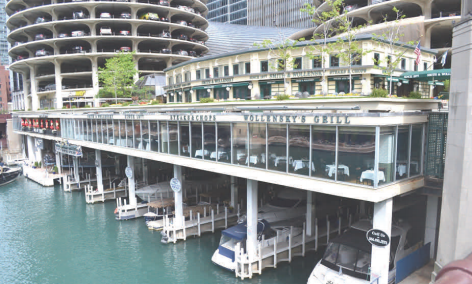 |
| chicago.gov, p36 |
 |
| Marina City posted August 18, 1974. A boat speeds past Marina City in a race that was part of Chicago’s 17th annual Lakefront Festival. Racers reached speeds of 85 mph as they competed for cash prizes, according to the Chicago Sun-Times. Pulitzer Prize winner Bob Fila captured this image. People at Marina City are watching the race from the marina level – under the large “Apeco Marina” sign – and from the plaza level. “Apeco” stood for American Photocopy Equipment Company, which manufactured and marketed photocopy machines starting in 1952. In 1968, Apeco entered the marina products industry. Since 1995, it has been known as Comforce Corporation. |
 |
| US City Views posted Marina Towers, Chicago (1966) Completed in 1966, Marina Towers stands as a testament to innovative architecture and urban living in the heart of Chicago. Designed by architect Bertrand Goldberg, these iconic twin corncob-shaped towers broke new ground with their modernist design and unique structure. Rising 65 stories above the Chicago River, Marina Towers was envisioned as a "city within a city," providing residents with a self-sufficient environment. The complex featured residential units, office spaces, a theater, restaurants, and a marina, offering unparalleled convenience and lifestyle options. The daring cylindrical design and emphasis on vertical living set Marina Towers apart as a symbol of mid-20th-century architectural ambition and urban planning. Janice Reid: ANDDDD, it had a bowling alley!!!! |
 |
| US City Views posted Marina City Chicago (1965) In 1965, Marina City was a newly completed architectural marvel, symbolizing Chicago’s innovative spirit and urban renewal efforts. Designed by architect Bertrand Goldberg, the twin corncob-shaped towers stood out against the city’s skyline, representing a bold departure from conventional building designs. Marina City was conceived as a “city within a city,” featuring residential apartments, a marina, parking facilities, and various commercial spaces. This mixed-use development aimed to revitalize urban living, offering residents a blend of convenience and modern amenities. The project’s completion marked a significant milestone in Chicago’s architectural history, showcasing the city’s commitment to forward-thinking urban planning and design. [A new angle of the towers. If I were a good little researcher, I'd find the location of that gasometer in the background.] |
 |
| Historic Chicago posted |
 |
| Thomasmall Small shared his post |
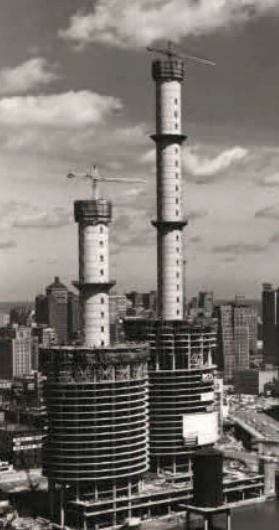 |
| Dennis DeBruler commented on Thomassmall's post Since the progress of construction of the posted photo is less than this one, and this one is dated 1961, I'd put the date at 1961. |
 |
| Historic Chicago posted Marina Towers, Chicago, under construction. (1962) In 1962, construction of the Marina Towers on State Street marked a bold new era in Chicago’s architectural history. Designed by architect Bertrand Goldberg, the twin "corn cob" towers stood in stark contrast to the city’s more traditional skyscrapers. Their curved, cylindrical shape and unique design symbolized a departure from conventional architecture. Each floor of the towers was a continuous spiral of concrete, with residential units featuring curved balconies offering panoramic views of the Chicago River and the city skyline. Marina Towers became an iconic part of Chicago's skyline, representing modernism, innovation, and the city's ongoing pursuit of architectural excellence. Jeff Grunewald: The only "spiral" is the parking ramp. [And it is Marina City instead of Marina Towers.] |
This looks like a different view taken at the same time.
 |
| Historic Chicago posted Get this amazing print for free, simply go to www.shopcitymerch.com/marinacity Historic Chicago posted again US City Views posted Marina City Under Construction Chicago (1960s) During the 1960s, Marina City, one of Chicago's most distinctive architectural landmarks, was under construction along the Chicago River. The twin corncob-shaped towers, designed by architect Bertrand Goldberg, represented a bold experiment in urban living. Marina City was envisioned as a "city within a city," featuring residential units, offices, shops, and a marina. The construction of Marina City symbolized Chicago's commitment to innovative design and urban planning. Completed in 1964, the complex remains an iconic part of the city's skyline, attracting residents and visitors alike with its unique architecture and prime location. |
 |
| US City Views posted Bird’s-eye view of Marina City towers Chicago during construction (1962) In 1962, the construction of Marina City, an ambitious mixed-use development on the Chicago River, was well underway. Designed by architect Bertrand Goldberg, Marina City was a pioneering project that sought to bring residential living back to the urban core at a time when many people were fleeing to the suburbs. The bird’s-eye view of the twin towers during construction reveals the unique cylindrical design, which was unlike anything else in the Chicago skyline. The buildings, often referred to as the "corn cob towers," were notable for their innovative use of concrete and their multifunctional design, which included residential units, a marina, commercial spaces, and parking. When completed, Marina City would stand as a symbol of modern urban living and architectural experimentation in Chicago. |
 |
| Historic Chicago posted Marina City under construction. (1960s) |
 |
| David S McCoy commented on Historic Chicago's post |
Eric J. Nordstrom posted three photos with the comment:
photographic images (scanned from single contact sheet) of bertrand goldberg's marina city (1968) taken during its construction.unidentified photographer.courtesy of bldg. 51 archive.
Gail Young-Fearon's Husband: The pictures had to be closer to 1964 ish.
Eric J. Nordstrom also posted with the same comment.
 |
| 1 |
 |
| 2 |
 |
| 3 |
 |
| Elin B Papciak posted Chicago River, 1962 Ian Ross: One of the boats reminds me of the DC Everest. It used to run between the pulp and paper mills, like Marathon, on the north shore of Lake Superior, down to the lower lakes and places like Chicago, hauling rolls of newsprint for the big city dailies. Doug Dewey shared Found in another group. Anybody know the boats? William Lafferty: Lachinedoc to the west, Sarniadoc aft. The Calgadoc, Torondoc, and Coteaudoc laid up that brutal winter at Lake Calumet. Each had storage cargoes of newsprint for the Sun Times and Daily News. Doug Dewey: William Lafferty paper boats owned by the Sun Times? I know Tribune owned their boats at one point. William Lafferty: Owned by N. M. Paterson & Sons., Ltd., Fort William, Ontario. The Tribune's boats were owned by its wholly owned subsidiary Quebec & Ontario Transportation Co., Ltd., Montréal. |
 |
| Historic Chicago posted Marina Towers under construction. (1963) |
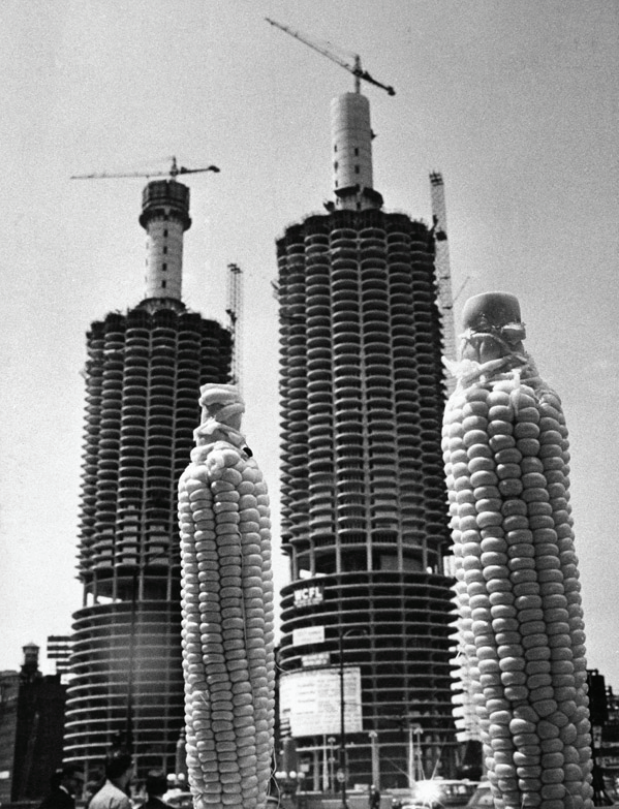 |
| chicago.gov, p44, By a photographer at the Chicago Daily News, circa 1961. |
 |
| Ben Kotowicz posted Marina Towers 1963 My father worked at the First National Bank as an elevator mechanic. This photo was taken from the old First National Bank building. It was twenty stories. My father took me to the roof where I took the photo. It was summer of '63. Eighth grade was next. John Czerwiec: Wow! The contrast between the modern and much older buildings could not be more stark! As things in the greater North Loop we’re still kind of seedy into the 80s it’s interesting to see this as the “break with the past”… |
 |
| Historic Chicago posted State Street (1960s) Russ Burgos: Taken between June 29 and July 19, 1962. Both pictures, "Bon Voyage!" (starring Fred MacMurray and Jane Wyman) at the State-Lake and "The Notorious Landlady" (starring native Chicagoan Kim Novak and Jack Lemmon) at the Chicago, opened Friday, June 29. "The Music Man" opened at the Chicago on July 20. |
 |
| Historic Chicago posted Construction of the Marina Towers. (1960s) Historic Chicago posted again with the same comment |
A 1959 view showing that it was built over the C&NW State Street Railyard and it was surrounded by warehouses.
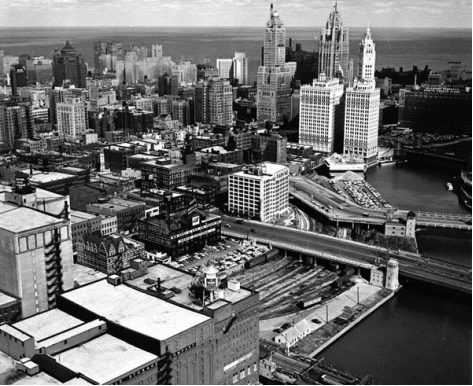 |
| chicago.gov, p7 |
This source puts the date of the photo as 1950.
 |
| marinacity.org-tracks via marinacity.org-history The 135,000 sq. ft of C&NW land was bought for $2.5m, $500,000 less than the asking price. |
The saddle-shaped theater was the last element of the city-within-a-city (residential, office, hotel, commercial, parking, etc.) complex and it was completed in 1967.
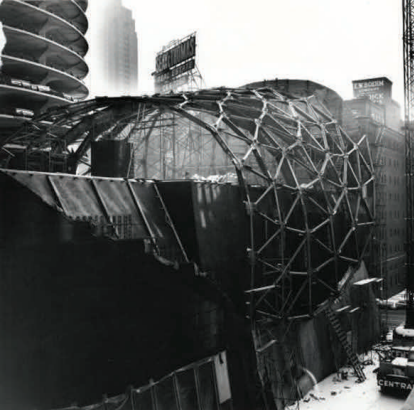 |
| chicago.gov, p21 |
Goldberg exploited the opportunity to build with curves using concrete. This style of using curves is called "the Expressionist Style within the Modern Movement in Architecture." [chicago.gov, p38]
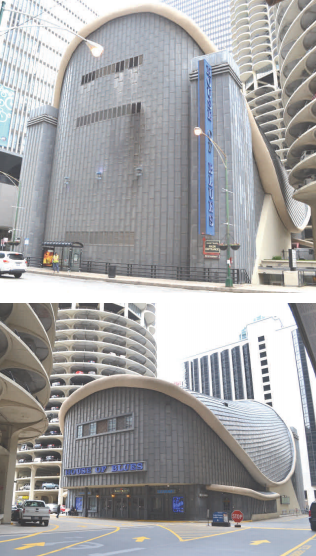 |
| chicago.gov, p36 |
This view shows the side of the office building that was on the north side of the development. Goldberg viewed that building as a 16-story "fence." During a meeting in 1993, he called the office building his “visual barrier, blocking out the slum property to the north.” [marinacity.org-fence via marinacity.org-history] The radio antennae is a reminder that this was a tall building in the early 1960s.
 |
| bertrandgoldberg.org |
 |
| Historic Chicago posted Marina City towers at dusk on 300 North State Street. (1965) |
 |
| Historic Chicago posted Marina Towers at night. (1967) Growing up in Chicago posted 1967 - Marina Towers at night. |
 |
| Bill Layton commented on the second post Years later. |
 |
| Edgar Ramirez commented on Historic Chicago's post |
 |
| Historic Chicago posted, cropped Marina City (1972) John Davis: I remember when they were selling them as condo units, $26,000 for studio apartment, $41,000 for 1 bedroom. But you could buy a three flat for that in those days. Kenneth Gholar: John Davis but it was about the only place to live downtown at the time. |
 |
| Historic Chicago posted The parking garage at Marina Towers. (1963) Rich Verson: Marina City. Never Marina Towers. Terri Kimball Hart: Lived there briefly in the mid 60s. Never saw the garage. They brought the car to me. Ab Cityguyabc: Terri Kimball Hart I believe they still do, it's not self park. [Some comments talk about the stunt of driving the car off the garage and into the river for the movie The Hunter. YouTube of the scene The stunt company must have got paid by the wreck. Unless you like watching gratuitous wrecks, skip to 2:31.] Juan Morales shared |
 |
| Larissa Chaw posted Marina City Towers in Chicago, designed by Bertrand Goldberg and completed in 1964, are iconic for their unique cylindrical shapes resembling corncobs. Located at 300 North State Street, the 65-story mixed-use complex was one of the first post-war high-rise residential buildings in the U.S. Designed as a "city within a city," it features residential units, a theater, gym, pool, ice rink, supermarket, and restaurants, along with a marina. The towers' reinforced concrete construction and circular design were aimed at maximizing natural light and urban space efficiency, significantly influencing modern architectural approaches to integrated urban living. © Photo: Robert Creek |
The target for the residents were singles and couples without children. It was the first circular apartment buildings in history.
 |
| SkylineArchitecture |
- Theater
- Gym
- Swimming Pool
- Ice Rink
- Bowling Alley
- 19-floor Parking Garage
- Retail Shopping and Restaurants
- Marina
- Laundry Facilities with Panoramic Views of the City360-Degree open-roof deck on top of each building
 |
| 2:23 video @ 1:59 |
 |
| Windy City Ballyhoo: Chicago's Moviegoing Past posted Chicago photographer Val Mazzenga recently passed away and it seems like a good time to celebrate his incredible work, like this exciting shot of Marina Towers being used in an iconic stunt for the Steve McQueen action film The Hunter (1980). Michael Kanalas: They destroyed and Eyemo camera ( a 35mm Bell & Howell ) and a 20mm Baltar lens to get the shot from inside the car, the problem was that the car was supposed to bounce up in the water, however it stuck in the riverbed muck and they had to kill off the guy in the car because originally he was supposed to escape in show up later in the film. The film magazine snapped off on impact and those who saw the footage said it was great. Jim Griffin: I was there that day. McQueen was watching in a boat on the river. Very cool. Mario C. E. Freese: low steel frames 6ft apart and two wires was all it took back then to form a railing barrier made to code preventing a 200ft drop to certain death. Greg Daunoras: McQueen passed later in 1980. Adam Carston posted Photo by Val Mazzenga Don Marshall: Very cool, I was there watching, they shot two versions of the scene. One car had an engine in it, the other did not.It made a big difference in the way the car flew into the river. |
 |
| Nathan McMuir posted 1980 Marina tower on location shooting the Hunter. Anthony Tony Halachoulis: Engine, transmission and gas tank had to be removed for stunt. Bill Oerke: Anthony Tony Halachoulis How did the shoot the car out that far then? Don Marshall: Bill Oerke They rammed it off of the edge using a tow truck, I was on set to watch that day. There was two takes, one take, had the engine in, one take did not, it changed angle of the cars diving into the water. David Fontanetta Jr.: The car actually went deeper into the muck on the bottom of the river than they anticipated. The camera inside was destroyed but the film canister survived. Megan Green shared a different exposure |
 |
| Xavier Quintana posted A sedan plunges from the 15th-floor level of Marina City's parking garage into the Chicago River in 1979. It was a stunt for the Steve McQueen movie, "The Hunter." (Vintage Tribune) |
No comments:
Post a Comment